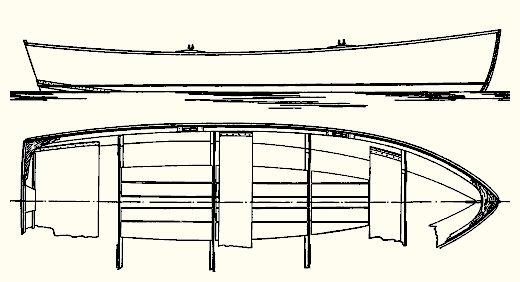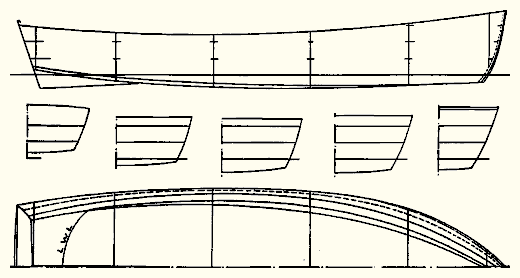
| H. C. O. A 12' 1" Aluminum Skiff By William & John Atkin |
| A Twelve Foot Aluminum Skiff | |
| The design this month shows a shipshape little flat bottom skiff that will be equally at home if propelled by outboard motor or a pair of spruce oars. Builders of this skiff can be sure of excellent performance if the plans are followed exactly and will find themselves in possession of a very useful boat. The skiff should go well up to speeds of approximately 8 miles an hour carrying an outboard motor of 4 1/2 to 5 h.p. and I would not think of using more than this power. With a motor of 2 1/2 h.p. the speed will be 6 1/2 miles and hour. | |

| |
Unlike any design published before in this series of articles, the skiff H. C. O. is built of aluminum, excepting only the sheer mouldings, knees, inwales and floor boards, these being made of wood. Aluminum should last well in a small boat and if put together properly a boat built of this metal should last as well as one built of white oak and white cedar, assuming, of course, both are equally well cared for. Aluminum will be much easier to work than either sheet iron or steel, and a metal hull because of its fewer parts should go together quicker than a hull built of wood in the conventional manner. The melting point of aluminum is only 1,220 degrees Fahrenheit and because of this low melting point aluminum is most difficult to weld. Therefore this little boat, H. C. O., will be riveted together. As to length of life of aluminum it may be interesting to mention that in the year 1884 a piece of cast aluminum was set on top of the Washington Monument to form the tip of the marble pyramid and was found at an inspection several years ago little affected by its long, long vigil atop the 555-foot memorial tower. The deck plan shows a wide after seat and two rowing seats or thwarts. The forward face of the after seat reaches from the top of the seat to the sides and bottom of the hull and thus forms a water-tight flotation tank. The forward rowing thwart is made in the form of a rectangular tank and so it serves also as a flotation tank. Both tanks will float very close to 180 pounds and so the aluminum boat will not sink with a small outboard motor attached to its stern. The seats, like the shell plating, will be made of 1/8 inch aluminum. | |

| |
| H. C. O. has an over all length of 12 feet 1 inch; a breadth of 4 feet; and a draft of 4 inches. The freeboard at the bow is 1 foot 7 1/2 inches, at the lowest place 1 foot 1/2 inch; and at the stern, 1 foot 3 inches, and, so you see, she is big enough to be comfortable and safe for two or three average weight people. It will be noticed that the topsides and the bottom sections are convex curves; the reason for this form of section is that single pieces of plating will go into place more easily and the convex surfaces will be less likely to show "buckles" and other uneveness after it is fastened. And these surfaces contribute to the strength of the hull and resist any tendency for the bottom or topsides to pant. | |
| Plans for H. C. O. are $100 MYSTIC SEAPORT MUSEUM SHIPS PLANS STORE https://store.mysticseaport.org/ships-plans/ shipsplanstore@mysticseaport.org
+1 (860) 572 5360 | |
| BACK TO PLAN LIST | |